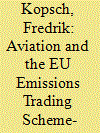| Srl | Item |
| 1 |
ID:
115704


|
|
|
|
|
| Publication |
2012.
|
| Summary/Abstract |
Designing an emissions trading scheme requires in-depth knowledge regarding several aspects. This paper attempts to clarify some important design points of the forthcoming emissions trading scheme for aviation under the EU ETS. Five general key points of system design are acknowledged and comparisons are made to previous and current emission trading schemes. While it is not meant to be exhaustive it helps to create an understanding of what design elements should be handled with caution. Discussion is provided in regard to the recent implementation of aviation in the EU ETS. Above all, it is argued that initial allocations of emission permits and the trade barrier between the aviation sector and EU ETS need to be carefully examined.
|
|
|
|
|
|
|
|
|
|
|
|
|
|
|
|
| 2 |
ID:
088217


|
|
|
|
|
| Publication |
2009.
|
| Summary/Abstract |
This study simulates a CO2 permit market in Romania using a dynamic general equilibrium model. The carbon constraint is set at 20.7% below the reference emissions level for sectors eligible according to the European Union Emission Trading Scheme (EU-ETS). Free permit distribution enhances growth despite a severe emissions cap, because environmental regulation stimulates structural changes [Porter, M., 1991. American's green strategy. Scientific American 264, 168]. That is, grandfathering allows sectors additional resources to invest in developing technologies, but it also raises the CO2 abatement costs because of energy rebound effects from enhanced growth. Results under endogenous growth [Romer, P.M., 1990. Endogenous technological change. Journal of Political Economy 98 (5), 71-102] are very similar to those obtained under an exogenous growth scenario [Ramsey, Y.F., 1928. A mathematical theory of saving. Economic Journal 38, 543-559], as the substitution effects are responsible for the majority of variations; in addition, Romanian research activities are too modest to significantly impact this system. The abatement cost per unit of GDP is higher under endogenous growth, as spillover effects reduce incentives to invest. Technological diffusion continues to have a positive impact on economic growth, which counterbalances the free-riding attitude adopted by some energy-intensive sectors, such as glass and cement.
|
|
|
|
|
|
|
|
|
|
|
|
|
|
|
|